Release Date :
Reference Number :
2018-006
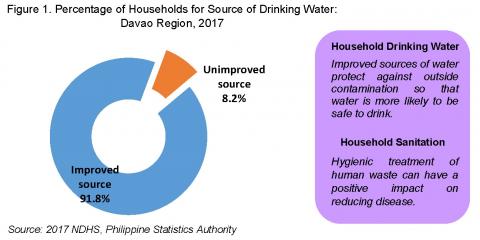 This special release presents key indicators on fertility, fertility preferences, family planning practice, childhood mortality, maternal and child health, knowledge and attitude regarding HIV/AIDS, and violence against women.
This special release presents key indicators on fertility, fertility preferences, family planning practice, childhood mortality, maternal and child health, knowledge and attitude regarding HIV/AIDS, and violence against women.Majority of households use an improved source of drinking water
In the result of the 2017 National Demographic and Health Survey (NDHS 2017), Davao region posted a 91.8 percent of the households were using an improved source of drinking water.
On the other hand, in terms of unimproved drinking water source, Davao region belonged to the bottom five regions with the most number of households with unimproved drinking water source. The following regions with high rate of unimproved water source were: Autonomous Region in Muslim Mindanao (29.1%), Cordillera Administrative Region (15.4%), Region IX-Zamboanga Peninsula (9.2%), Region V-Bicol Region (8.7%) and Region XI - Davao Region (8.2%).
Sixty-eight percent of households have improved toilet facilities
In Davao region, most of the households (67.8 percent) used improved toilet facilities that are not shared with other households, while 26.6 percent of the households used shared sanitation facilities. On the other hand, 5.0 percent of the households used non-improved sanitation facilities and the remaining 0.8 percent of the households have open defecation sanitation facilities.
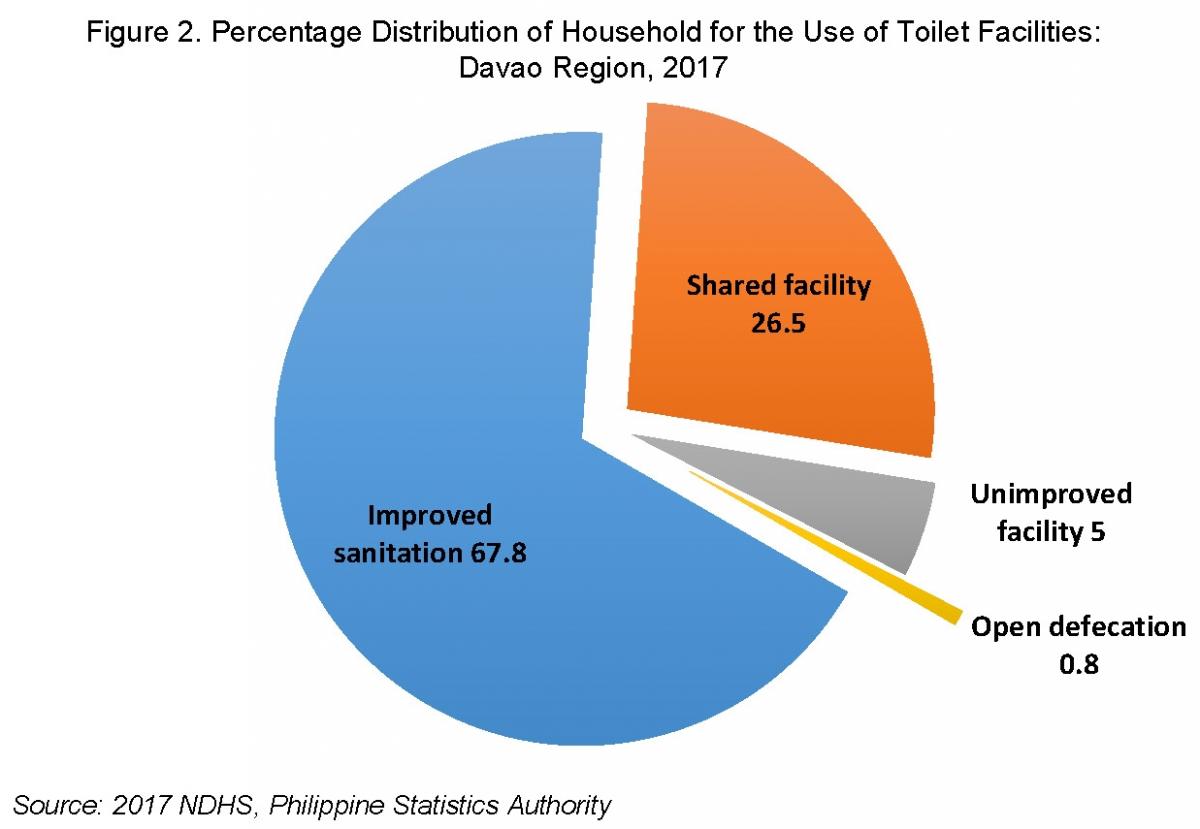
Sixty-nine percent of household members are covered by PhilHealth
Around sixty-nine percent of the household population in Davao Region has any form of Philhealth insurance membership. Of the total members, 20.0 percent were members under the formal economy, 14.7 percent were covered through informal economy, and 26.4 percent were indigent members. Another 1.1 percent were sponsored members, 0.5 percent were lifetime members. 5.7 percent were senior citizen members and 1.3 percent were overseas Filipino members.
Meanwhile, one-fourth of the household population in the region has other forms of health insurance such as the Government Service Insurance System (GSIS), the Social Security System (SSS), or private insurance company.
Sample women respondents are about 4.8 percent
In the NDHS 2017, a total of 25,074 women aged 15-49 years old were interviewed. Out the total, about 1,266 women or 4.8 percent were sampled from Davao Region. Higher percentage of sample women were in the National Capital Region (NCR) and Region IV-A Calabarzon with 17.5 percent and 16.0 percent, respectively.
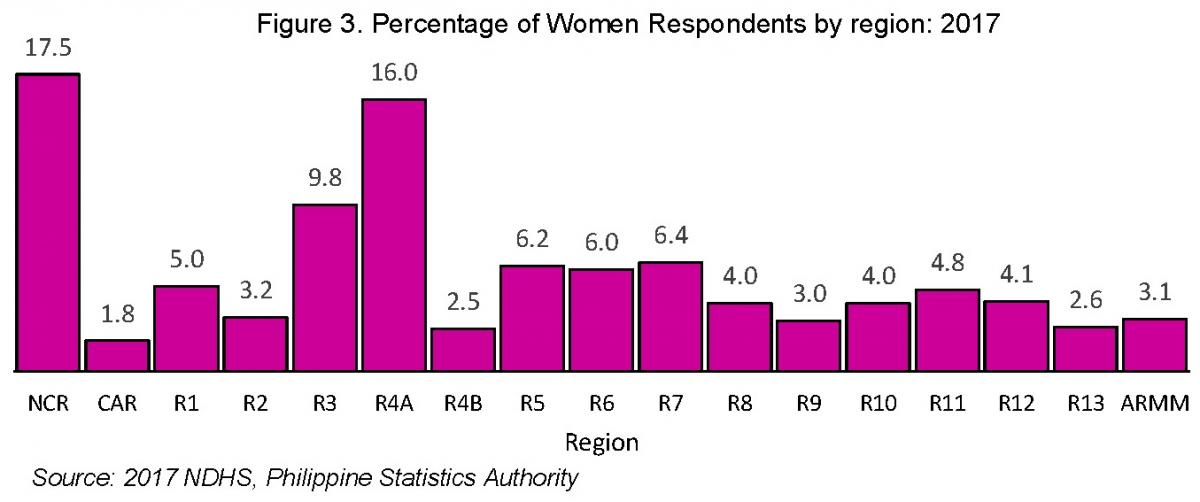
Highest percentage of early pregnancy was recorded in the region
Figure 4 shows the percentage of women age 15-19 who have had a birth or were pregnant with their first child at time of the survey. Overall, about 17.9 percent of young women age 15-19 in the region have begun childbearing. This proportion almost doubles the national figure’s 8.6 percent of women age 15-19 who have begun childbearing. Among the 17 administrative regions, Davao Region posted the highest percentage of teenage pregnancy. This was closely followed by Region XII, SOCCSKSARGEN and Region X Northern Mindanao with 11.8 percent and 11.6 percent, respectively.
Of those teenage women who have begun childbearing, approximately 16 percent who have had live birth, and the 2 percent who were pregnant with first child at the time of the survey.
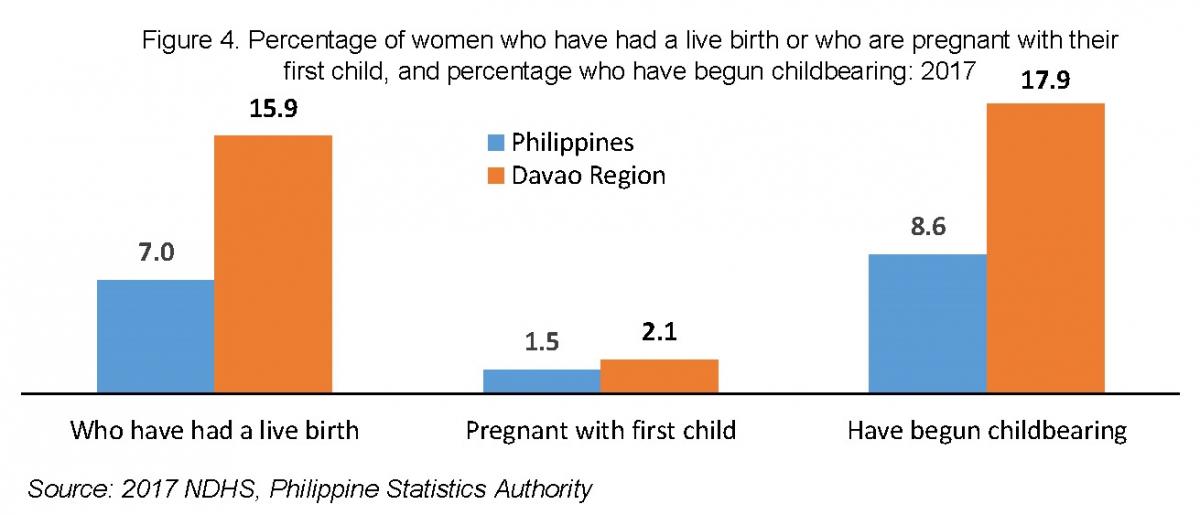
Most married women currently used any modern method
About six in ten of married women (62.2 percent) were currently using any method of contraception in the region. This figure is higher by 16 percent from the 53.8 percent in the NDHS 2013. Most contraceptive users rely on a modern method (48.9 percent) and only 13.2 percent were using on a traditional method. The use of modern method increased by 25 percent from the previous NDHS survey round. On the other hand, about 37.8 percent of married women reported of not currently using any method of contraception.
Among the type of modern method, pill was the most used method by married women at 28.1 percent. This figure showed an increase of 27 percent pill users compared to the 22.1 percent in the NDHS 2013. Female sterilization and IUD were the current methods reported by the 6.5 percent and 5.9 percent married women, respectively.
For the traditional method, about 9.0 percent of married women currently used withdrawal as contraception.
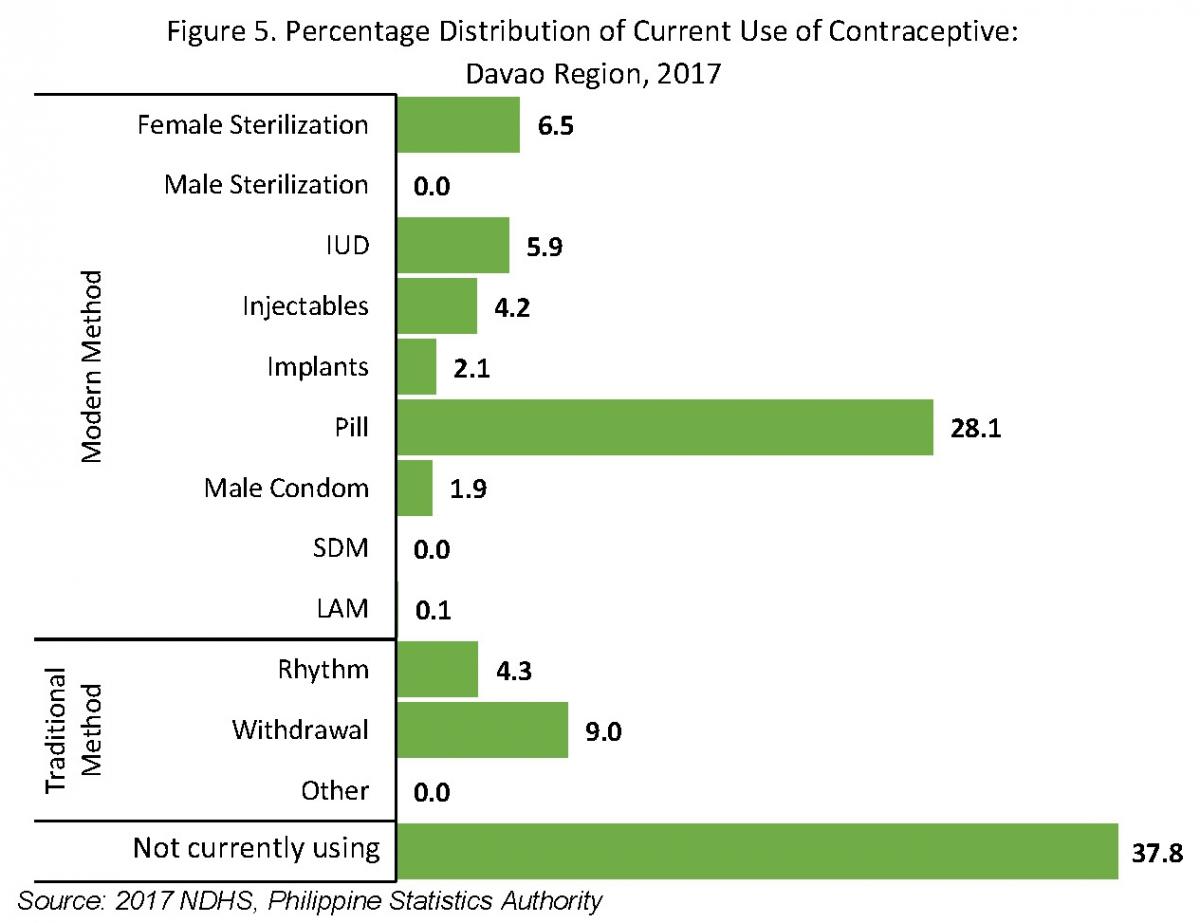
Total demand for family planning increased in 2017
Among currently married women, there has been a slight decline in the unmet need for family planning from 17.5 percent in 2013 to 13.5 percent in 2017. In contrast, the met need for family grew from 53.8 percent in 2013 to 62.2 percent in 2017. This figures resulted to a 75.7 percent of total demand for family planning, which is higher compared to the 71.3 percent in the previous NDHS survey round.
Meanwhile, the percentage of the demand for family planning that is satisfied with modern contraceptive methods has increased from 55.1 percent in 2013 to 64.7 percent in 2017.
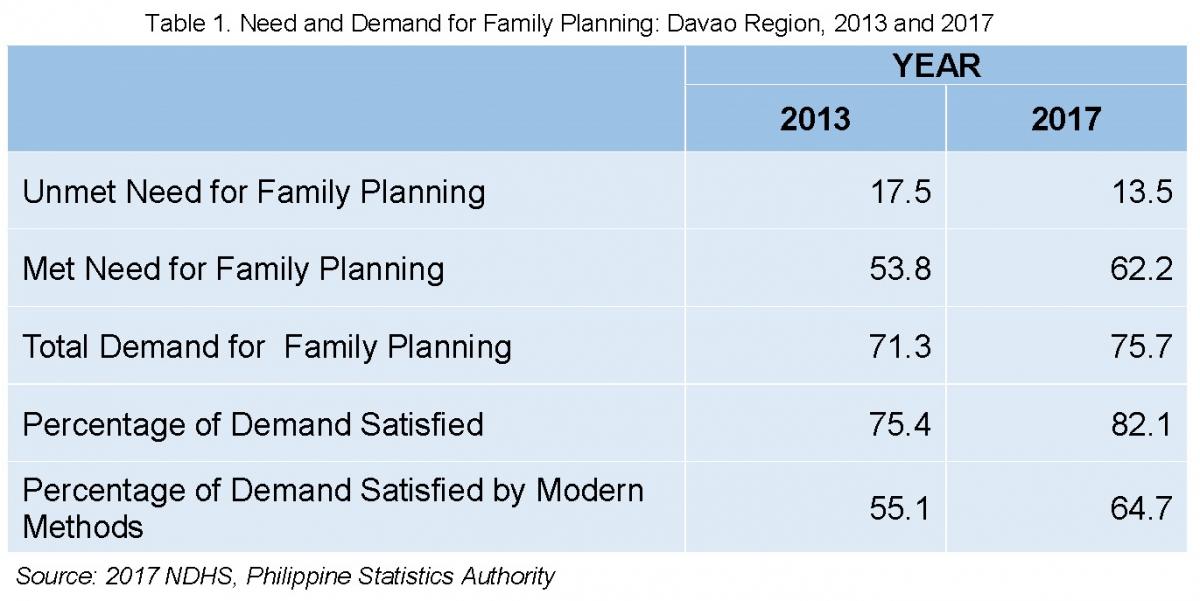
High percentage of women received antenatal care
In Davao region, about 92.8 percentage of women who had given birth in the five years preceding of the survey received antennal care (ANC) from a skilled provider. With this, there were about 91.9 percent of women had received four or more ANC visits.
About 82.4 percent of women with a recent birth in the five years before the survey were protected against tetanus toxoid. Meanwhile, there was about 90.6 percent of women who had postnatal check during the first two days after birth. The percentage of women who had postnatal care in the region increased by 2.7 percent from the
88.2 percent in 2013.
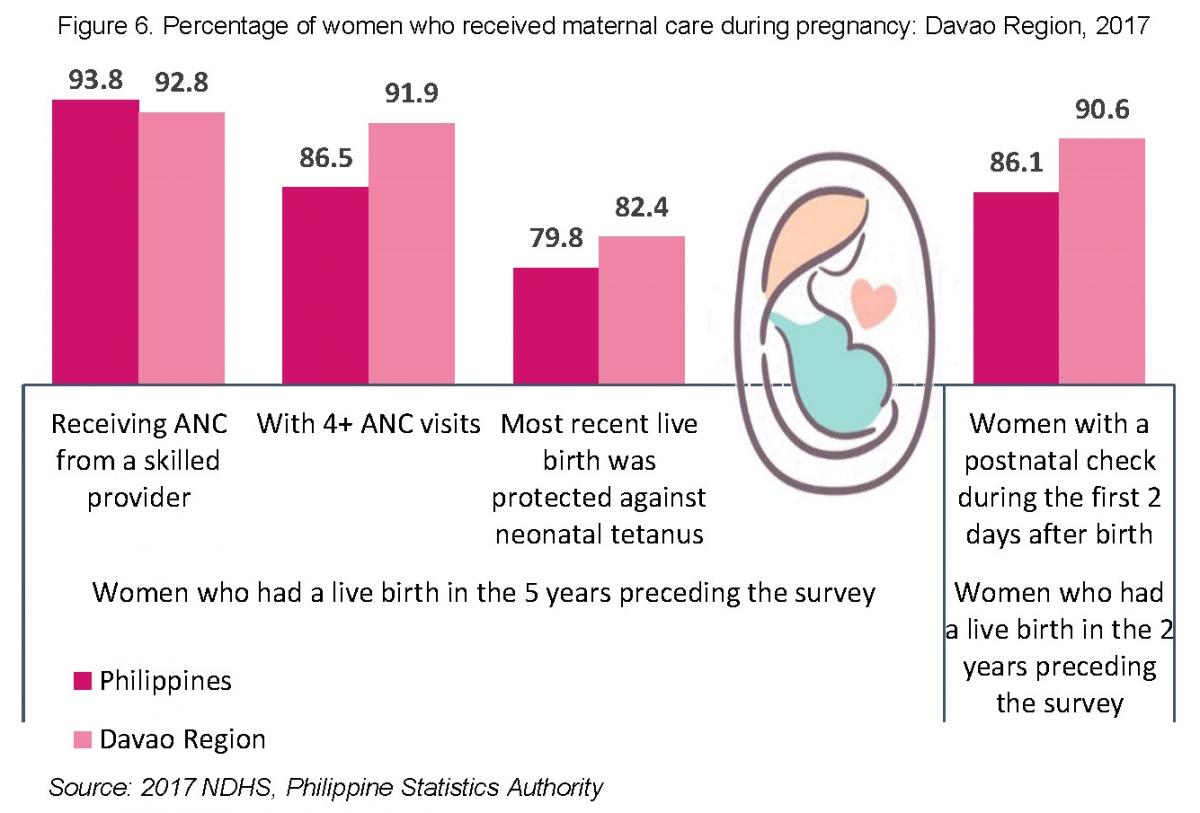
About 82 percent of births were attended by health professionals
Over the past four years, there was an huge increase in the proportion of births in the region attended by health professionals from 67.7 percent in 2013 to 82.0 percent in 2017. Out of the live births attended by health professionals, about 15 percent of live births were delivered through a caesarean section.
Majority of live births (74.1 percent) were delivered in a health facility. The proportion of live births delivered in a health facility greatly increased by 17.8 percent from 62.9 percent in 2013.
Vaccination coverage expanded by 9.7 percent
Overall, 78.0 percent of children age 12-23 months in the region are fully immunized, that is, they received the seven basic vaccinations (BCG, measles, and three doses each of DPT, polio and Hepa-B) before reaching the age one. This figure is higher
by 9.7 percent compared from the 71.1 percent vaccination coverage in 2013.
With regard to specific vaccines, coverage is generally high for each type of vaccine; 98.8 percent of children have received the BCG vaccine, 98.4 percent have received the first dose of DPT, 98.2 percent have received the first dose of hepatitis B vaccine, 98.4 percent have received Hib vaccine and 97.9 percent have received the first dose of polio vaccine.
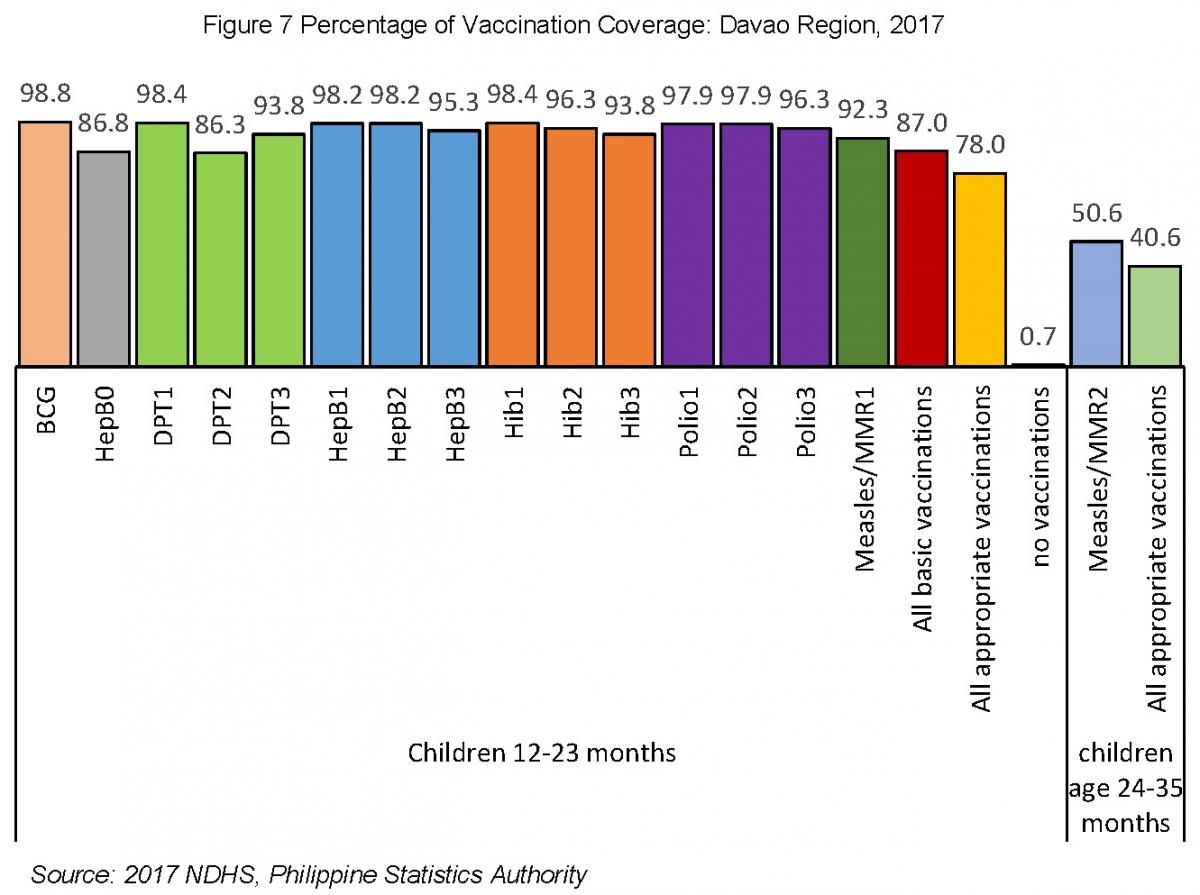
More half of women have knowledge on HIV Prevention
In terms of knowledge of women age 15-49 on how to prevent HIV, about 69.9 percent of women in the region said that HIV can be prevented by using condom during sexual intercourse, while 86.7 percent said that HIV can be prevented by limiting sexual intercourse to only one uninfected partner and 65.1 percent said that HIV can be prevented by using condom and limiting sexual intercourse to one uninfected partner.
Meanwhile, the proportion of women age 15-24 who knows the comprehensive knowledge on HIV prevention was only 27.4 percent in the region.
Every woman averaged two sexual partners
Four in ten women age 15-49 in the region posted that they had more than two partners in the past 12 months preceding the survey.
Among women who had sexual intercourse, the mean number of lifetime sexual partners is 2.1. This figure was the highest among all the regions reported.

More women experienced different types of violence
In the region, the percentage of women who experienced physical or sexual or emotional from their multiple partners posted 26.9 percent, while 16 percent of women experienced physical or sexual violence. Two in ten women have experienced emotional violence. There was 15.7 percent of women who reported that they experience physical violence from their sexual partner. Meanwhile, 4 percent of women experienced sexual violence.

RUBEN D. ABARO, JR.
OIC-Regional Director
PSA-XI
